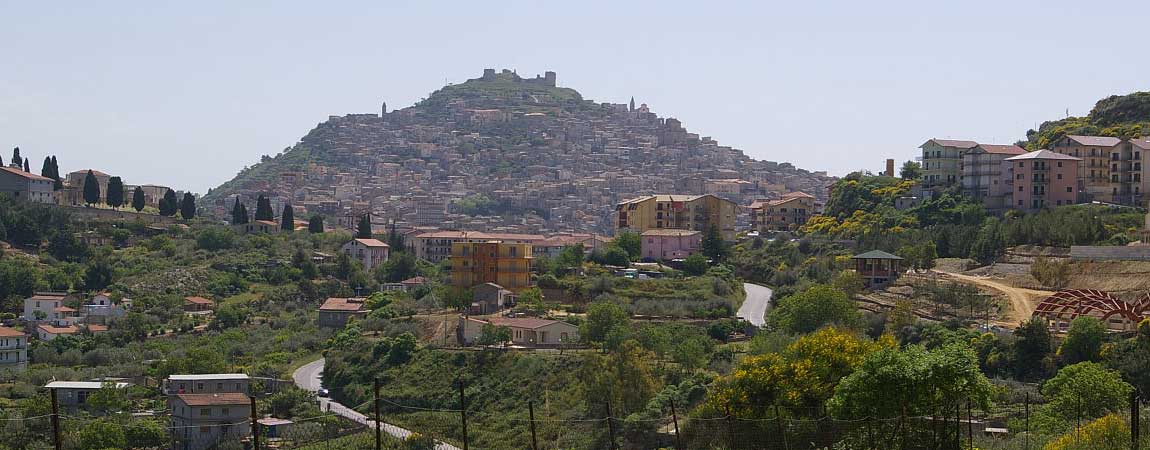
The myth tells that Agira was founded even before the Trojan war and that it originated the birth of the first cities of Sicily.
Located on a hill overlooking the Dittaino and Salso valleys and the nearby hills, the town has an interesting millennial history which sees it among the first settlements born in the interior of the island.
Its name comes from the Greek Argyrion, which translated means silver and it seems that in this area there were active mines of this metal that were in existence until the sixteenth century.
Agira was known by Cicerone and Tolomeo and it was the city where the Sicilian historian was born Diodorus Siculus in the XNUMXst century BC
Archaeologists trace its birth back to the XNUMXth century BC under the Greek name of Agyrion but it seems that there was already an urban agglomeration earlier as evidenced by finds dating back to prehistoric times which suggest that its first inhabitants were Afro-Asian nomads.
However it is documented by caves and natural cavities present in the area, that this was inhabited in the Palaeolithic, Neolithic and Bronze Ages, as ascertained by traces still visible today and attributable to the Sicani.
In fact there is a theory that states that the name Agira could be derived from a Sican chief named Agiride. What is certain remains that the town was definitely one of most important centers of the island even before the foundation of Syrakousai and Akragas. When the Siculi arrived in the XNUMXth century BC, the already present Sicani retreated, leaving the territory free which was taken over by the Siculi.
The fundamental importance of Agira is also evident in the many churches that were built, as well as a Castle located 820 meters above sea level and dedicated to San Filippo di Argirò to whom a Greek monastery was also dedicated.
What to see in Agira
Il village of Agira offers the opportunity to visit various small churches, the remains of the medieval castle, the nearby lake of Pozzillo and much more. Here are our suggestions.
Agira Castle
Probably since the Sican era there was a building right at the top of the mountain where the first Heads of the Agiro people resided, later replaced by the Sicilian tyrants. In fact, in addition to the Castle, there seems to have been a massive wall characterized by a cyclopean access door.
In the Greek period and then in the Roman and Byzantine periods, the Castle was used only as a representative point. It was the Arabs who destined it again as fortress modifying the structure which was equipped with three walls of which the first was made in a ring that framed the mountain just below the castle. The second surrounded a lower part while the last had an irregular pattern as it followed the morphology of the rocky terrain and rose towards the Rocche di San Pietro.
In the mid-XNUMXth century the Castle hosted Louis of Aragon and in the sixteenth and seventeenth centuries, the building lost its military function gradually starting to decline so much that already in the eighteenth century it was already in ruins also due to the damage caused by an earthquake that occurred at the end of the seventeenth century which brought down the keep and damaged the central octagonal tower.
Neighborhood of the Rocche di San Pietro in Agira
Place of interest is the Neighborhood of the Rocche di San Pietro, undoubtedly one of the older areas of the town and dating back to the time of Arab domination. It is an urban fabric totally attributable to theArab art in Sicily, so as to be very significant in terms of artistic heritage e cultural.
Characterized by narrow streets, dead ends, balconies and noble palaces that keep the original structure intact with the traditional internal courtyard, the neighborhood stands out from the others for the scenic charm it offers to the visitor who has the impression that time has stopped .
Church of San Pietro in Agira
In the Arab quarter is the sixteenth century Church of St. Peter, among the most important historical buildings. The Church of San Pietro is simple and sober, with some statues placed on its facade that make it suggestive. The works of art kept inside are interesting.
The abbey of San Filippo
Built in the XNUMXth century on the ruins of the monastery outside the city walls, it was a point of reference for the monks. Restored during the Middle Ages at the behest of the Grand Count Roger I of Altavilla, the Abbey became garrison of the Benedictines but in the seventeenth century, it became the property of Colonna family, becoming an artistic point of reference. The building has a plan with three naves and inside there is the tomb of San Filippo discovered in 1596. There are also several paintings of a certain value such as portraits and paintings by Filippo Randazzo and the eighteenth-century works by Olivio Sozzi.
What to do in Agira
Do not miss Feast of the Patron Saint, San Filippo: A event's audience awaited by all the residents of Agira and by numerous tourists as well as by the inhabitants of neighboring countries. The Feast of San Filippo takes place on 12st May but also the eve is intended as an equally important day due to the activities related to the Festival which begin on the evening of 11 May. The procession takes place in the afternoon of May 12, crossing a path that starts from the Church of the Santissimo Salvatore and ends at the Abbey of San Filippo.
Being able to know what, according to legend, was the first city in all of Sicily it is certainly a fundamental stimulus for every shrewd tourist and for those who, a lover of history, want to have the opportunity to walk on the place where it all began.
© Image by Rainer Jehl, CC BY-SA 3.0, via Wikimedia Commons









